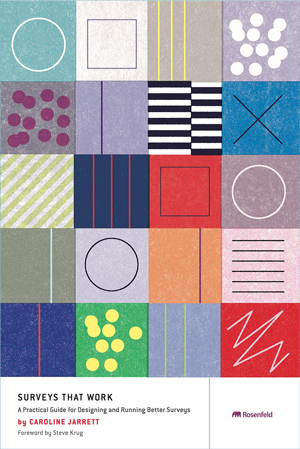 My book on surveys is: Surveys that work: A practical guide for designing better surveys.
My book on surveys is: Surveys that work: A practical guide for designing better surveys.
If you choose to buy directly from my publisher, Rosenfeld Media, then I’ll be extra happy. But I’m glad to say that it’s available from most online retailers or by ordering from your local bookshop.
The book has a seven-step process
The book takes you through a seven-step process for a survey starting with Goals and ending with Reports.
If you’d like to get a flavour of it, try: Surveys That Work: An excerpt from Chapter 1.
And if you want a speedy introduction, try: The least you can do to improve a survey
Get a discount or sample copy
If you are an event or book club organiser, an academic who would like a sample copy, or willing to commit to writing a review of the book, then Rosenfeld Media would like to hear from you. (Tip: they’re usually really good about this).
- Tell Rosenfeld Media about an event
- Tell Rosenfeld Media about discussing my book at a book club
- Rosenfeld media support for teaching academics
- Ask Rosenfeld Media for a review copy
Here are some additional resources that I couldn’t fit into the book
Chapters
Definitions Chapter: What is a survey? and the Survey Octopus
Chapter 1 Goals: Establish your goals for the survey
Chapter 2 Sample: Decide how many people to ask and how to find them
Chapter 3 Questions: Write and Test the Questions
Chapter 4 Questionnaire: Build and test the questionnaire
Chapter 6 Responses: Turn data into answers
Chapter 7 Reports: Show the results to decision-makers
Chapter 8 The least you can do
Spotlights
These are a collection of notes I made for the relevant sections of the book.
Spotlight A: Four different types of survey
Spotlight B: The Net Promoter Score and Correlation
Spotlight D: Statistical significance
Spotlight F: Questions to ask when you use a survey tool
Spotlight G: Choose your mode – web, paper or something else?
Spotlight H: “On a scale from 1 to 5” – Likert and rating scales
Spotlight I: A good chart is easy to read and honest
